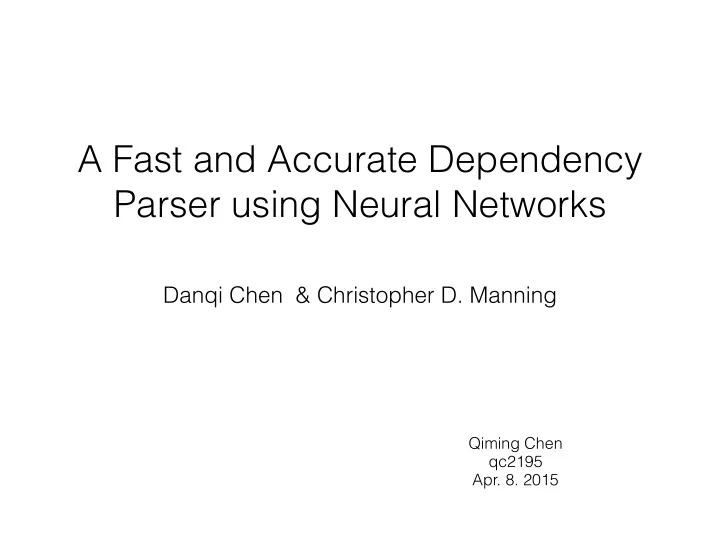

A Fast and Accurate Dependency Parser using Neural Networks Danqi Chen & Christopher D. Manning Qiming Chen qc2195 Apr. 8. 2015
Dependency Parsing • Parsing: He has good control .
Dependency Parsing • Parsing: He has good control .
Dependency Parsing • Parsing: He has good control . • Goal: accurate and fast parsing
Transition-based Parsing • A configuration = a stack, a buffer and some dependency arcs • arc-standard system is employed
Transition-based Parsing • A configuration = a stack, a buffer and some dependency arcs • arc-standard system is employed
Transition-based Parsing • A configuration = a stack, a buffer and some dependency arcs • arc-standard system is employed
LEFT-ARC
RIGHT-ARC
SHIFT
Traditional Features
Traditional Features • Sparse! • Incomplete • Computationally expensive
Neural Networks! • Learn a dense and compact feature representation • to encode all the available information • to model high-order features
Dense Feature Representation • Represent each word as a d-dimensional dense vector. • Meanwhile, part-of-speech tags and dependency labels are also represented as d-dimensional vectors. • NNS (plural noun) should be close to NN (singular noun).
Extracting Tokens from Configuration • We extract a set of tokens based on the positions: • And get their word, POS, deps
Extracting Tokens from Configuration • We extract a set of tokens based on the positions: • And get their word, POS, deps
Extracting Tokens from Configuration • We extract a set of tokens based on the positions: • And get their word, POS, deps
Model Architecture
Model Architecture
Model Architecture Cube activation function: g(x) = x^3
Model Architecture Softmax
Cube Activation Function
Training • Data from Penn Tree Bank (Wall Street Journal) • Generating training examples using a oracle. • Training objective: cross entropy loss • Back-propagation to train all embeddings. (Word, POS, dep) • Initialize word embeddings from pre-trained word vectors
Parsing Speed-up • Embeddings for popular words, POS tags, dep labels can be pre-computed and cached for speed-up • 8 ~ 10 times faster.
Indicator vs. Dense Features • Sparse? • Incomplete? • Computationally expensive?
Experimental Details • Embedding size = 50 • Hidden size = 200 • 0.5 dropout on hidden layer • A rich set of 18 tokens from the configuration • Pre-trained word embeddings: • C & W for English • Word2vec for Chinese
Cube Activation Function
Pre-trained Word Vectors
POS Embeddings
Dependency Embeddings
Summary • Transition-based parser using NNs • State-of-the-art accuracy and speed • Introduced POS / dep. embeddings, and cube activation function
Future Work • Richer features (lemma, morph, distance, etc) • Beam search • Dynamic oracle
Recommend
More recommend